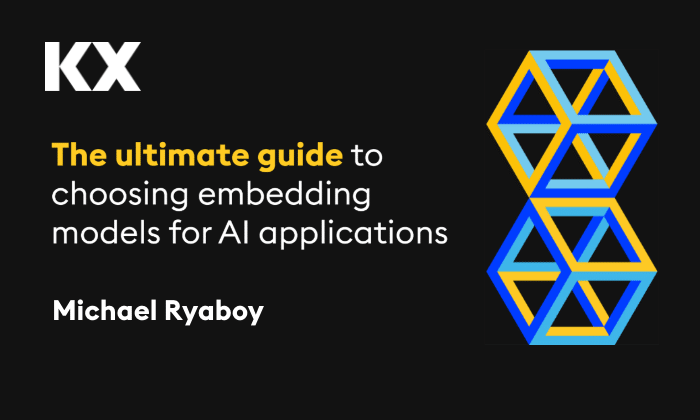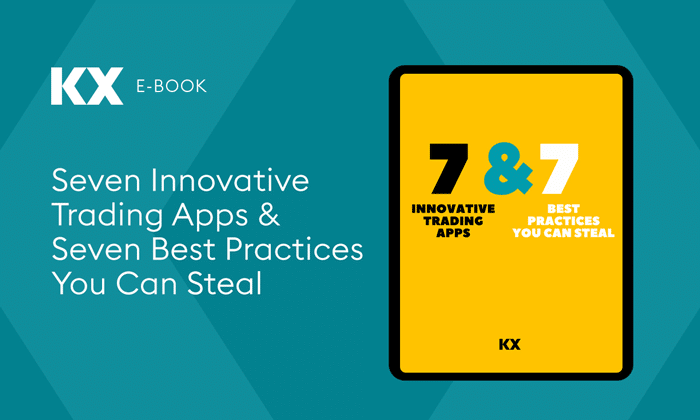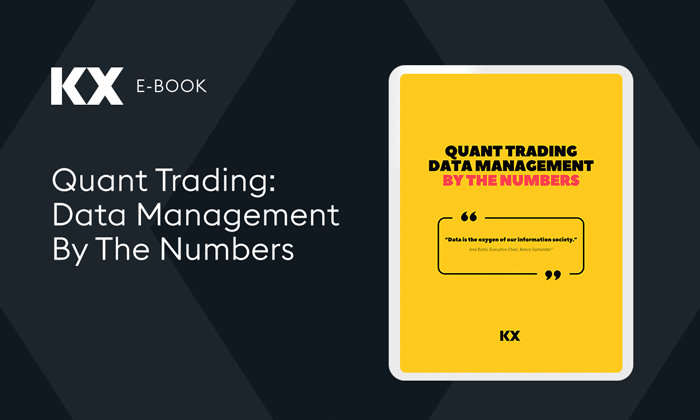KX Developer Advocate, Michaela Woods, shares seven key resources that outline how kdb+ is enhancing quantitative research to harness data and transform it into actionable insights.
Quantitative research in finance relies on tools like kdb+ to handle large data volumes and complex analyses, providing insights essential for effective trading strategies in modern markets.
The ability to analyze vast amounts of data, apply complex mathematical models, and derive actionable insights are crucial to be successful as a modern-day quant.
kdb+ has long been used to address the complex challenges of quantitative research, providing unmatched performance in analytics and real-time data processing. In this article, I share seven resources demonstrating how kdb+ and KX technology can be leveraged to solve various quantitative research problems.
1. Pairs trading
Link: Analyzing Pairs Trading Strategies with kdb+/q
This article explores the implementation and analysis of pairs trading strategies using kdb+/q. Pairs trading is a market-neutral strategy that involves trading two correlated financial instruments, betting on the convergence or divergence of their price spreads. Concepts covered include:
- Co-integration testing: Co-integration is a statistical property indicating that the price series of two assets move together over time. If the assets are cointegrated, it suggests that their price spread is likely to revert to the mean, making them suitable candidates for pairs trading.
- Spread calculation: The price spread between the two assets is calculated once co-integration is established. Monitoring this spread helps identify trading signals— a trade is initiated when the spread deviates significantly from the mean.
- Trade execution: The strategy involves executing trades when the spread crosses certain thresholds. For instance, when the spread widens beyond a predetermined level, the plan might include shorting the overperforming asset and going long on the underperforming one, anticipating a reversion to the mean.
- Backtesting: The article emphasizes the importance of backtesting the pairs trading strategy using historical data, ensuring its robustness before applying it to live markets.
The article serves as a valuable resource for quantitative researchers and traders interested in implementing pairs trading strategies using kdb+. It offers practical insights into the entire process, from data collection to backtesting, with a focus on optimizing strategy performance through real-time data integration.
2. Trend indicators
Link: Trend Indicators in kdb+
This whitepaper delves into implementing trend indicators using kdb+/q, focusing on popular indicators like Moving Average Convergence Divergence (MACD), Relative Strength Index (RSI), and Bollinger Bands. These indicators are widely used in quantitative research to identify potential trends and market conditions.
- MACD: The article walks through how to calculate the MACD by taking the difference between the 12-day and 26-day Exponential Moving Averages (EMAs) and plotting it along with a 9-day EMA of the MACD itself.
- RSI: It covers the computation of the RSI, a momentum oscillator that measures the speed and change of price movements, helping to identify overbought or oversold conditions.
- Bollinger bands: This section explains how to create Bollinger Bands, which consist of a moving average and two standard deviations plotted above and below the moving average, providing a visual representation of volatility.
It provides both the theory behind each indicator and practical examples of how to implement them in kdb+/q, making it a valuable resource for quantitative researchers looking to enhance their market analysis strategies with trend indicators.
3. Option pricing models: Monte Carlo and Black-Scholes
Link: Option Pricing in kdb+
This whitepaper explores the implementation of option pricing models using kdb+/q, with a focus on the Black-Scholes model and Monte Carlo simulations, two widely used methods in quantitative finance.
- Black-Scholes model: the article begins by explaining the fundamentals of the black-scholes model, a closed-form solution used to calculate the theoretical price of European options. It covers the key parameters like the spot price, strike price, volatility, risk-free rate, and time to maturity. The article then demonstrates how to implement the Black-Scholes formula in kdb+/q, offering code snippets and explanations for each step.
- Monte Carlo simulations: the article also delves into Monte Carlo simulations, which are used to model the probability of different outcomes in option pricing by running a large number of random simulations. It explains how to set up these simulations in kdb+/q, generate random paths for asset prices, and use these paths to estimate option prices.
- Comparison and practical applications: finally, the article compares the two methods, highlighting the strengths and limitations of each approach. It also discusses practical considerations when applying these models in real-world scenarios, such as computational efficiency and handling large datasets.
This resource is particularly valuable for quantitative researchers and financial analysts interested in implementing advanced option pricing models using kdb+/q.
4. Analyzing market depth
Link: Market Depth Analysis in kdb+
This article focuses on analyzing market depth data using kdb+/q, a critical aspect of understanding order book dynamics in financial markets. Market depth refers to the ability of a market to absorb large orders without significantly impacting the price, and it is visualized through the order book, which displays the buy and sell orders at different price levels.
- Capturing and Storing Market Depth Data: The article provides insights into how market depth data can be captured and stored efficiently using kdb+/q. It discusses the challenges of handling the high-frequency nature of this data and offers strategies for optimizing data storage and retrieval.
- Analyzing Market Depth: It covers techniques for calculating the market’s liquidity, identifying patterns in order flow, and detecting potential signs of market manipulation. It also suggests methods for plotting the order book and interpreting these visualizations to make informed trading decisions.
This resource is particularly useful for quantitative researchers and traders who need to analyze market-depth data to better understand liquidity and order book dynamics.
5. Transaction cost analysis
Link: Transaction Cost Analysis in kdb+
This article discusses the implementation of Transaction Cost Analysis (TCA) using kdb+/q, an essential process in assessing the costs associated with trading activities. TCA helps traders and quantitative researchers understand and minimize the costs incurred when executing trades, which can significantly impact overall portfolio performance.
- Components of TCA: The article details the critical components of TCA, including:
- Pre-trade analysis: Estimating potential costs before executing a trade.
- In-Trade Analysis: Monitoring costs as trades are executed.
- Post-trade analysis: Analyzing the actual costs incurred after trades have been completed.
- Implementing TCA in kdb+: It provides examples of how to calculate key metrics such as the Effective Spread, Implementation Shortfall, and Market Impact using kdb+/q. The article explains how to gather the necessary data, process it efficiently, and compute these metrics to gain insights into trading costs.
This article is a valuable resource for quantitative researchers and trading professionals who are looking to implement robust TCA processes using kdb+/q.
We also have a Jupyter Notebook available on the KX Academy showcasing TCA with PyKX.
6. Leveraging order book data
Link: Order Book Analysis in kdb+
This article covers the analysis of order books using kdb+/q, a critical component for understanding market behavior and price formation in electronic trading environments. The order book is a real-time list of buy and sell orders for a specific financial instrument, providing insight into market depth and liquidity.
- Order book metrics and analysis: the core of the article is dedicated to various metrics and analyses that can be performed on order book data using kdb+/q. These include:
- Order flow: tracking the sequence and size of orders to understand buying and selling pressure.
- Liquidity measures: calculating the total volume available at different price levels to assess market depth.
- Price impact: analyzing how large orders affect price movements and identifying potential market impact.
- Order book imbalance: measuring the difference between bid and ask volumes to gauge the likely direction of price movement.
This article is an essential resource for quantitative researchers and traders interested in leveraging kdb+/q for detailed order book analysis. It offers both theoretical insights and practical tools for making sense of complex market data.
7. Active vs. Passive strategies with kdb insights enterprise
Link: Create powerful analytics with kdb insights enterprise
This tutorial guides you through creating a trade signal and analyzing market positions using kdb Insights Enterprise, specifically for financial applications, offering examples such as:
- Moving averages for trade signals: the strategy calculates two simple moving averages—a fast (short-term) and a slow (long-term). A ‘buy’ signal is generated when the fast moving average crosses above the slow one, and a ‘sell’ signal is triggered when the reverse occurs.
- Position tracking: based on the crossover of these moving averages, positions are tracked using a new variable, positions. The position is set to +1 for a buy signal and -1 for a sell signal. Additionally, the logarithmic return on the price is calculated to analyze performance.
- Active vs. Passive strategy comparison: the final step involves comparing the active strategy (based on the moving averages) to a passive strategy, such as tracking an index like the S&P 500. The comparison is visualized to determine which strategy performs better, with the active strategy typically showing superior performance.
Streaming live tick data alongside historical data provides a comprehensive view of the market, enabling you to maximize opportunities. This tutorial demonstrates how kdb Insights Enterprise can be used to build and visualize powerful, real-time trading analytics, offering a detailed comparison between active and passive investment strategies while optimizing your market insights.
By exploring these resources, you can deepen your understanding of quantitative research techniques and leverage kdb+ and KX technology to develop more sophisticated and effective trading strategies.
| Learn | Connect | Build |
|---|---|---|
| Hone your understading of kdb+ at the KX Academy Enrol now |
Get faster responses to your questions from KX and community experts Join now |
Get hands-on with our extensive documentation and support portal. Explore now |
To learn more about kdb+ click here. To discover how KX is helping financial services organizations optimize trading, risk analytics, and decision-making click here.














